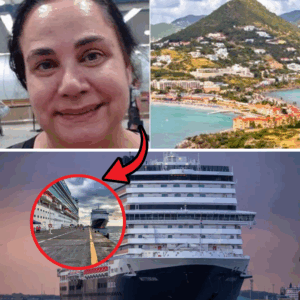Netflix’s latest triumph, The Waterfront, premiered on June 19, 2025, and has swiftly become a cultural touchstone, gripping viewers with its Southern gothic crime drama that hooks from the opening frame and never relents. Set in the fictional coastal town of Havenport, North Carolina, this eight-episode series, created by Kevin Williamson, immerses audiences in the turbulent saga of the Buckley family—a once-dominant fishing dynasty grappling with financial ruin, buried secrets, and a perilous descent into the drug trade. Inspired by true events and Williamson’s own coastal upbringing, The Waterfront blends the soapy melodrama of Dallas with the gritty stakes of Ozark, delivering a binge-worthy epic that’s as emotionally raw as it is thrillingly unpredictable. With a powerhouse cast led by Holt McCallany, Maria Bello, Melissa Benoist, and Jake Weary, the series explores themes of legacy, loyalty, and the extreme measures taken to protect family, all against a stunning yet treacherous coastal backdrop.
In an era marked by economic uncertainty, fractured family dynamics, and societal shifts, The Waterfront resonates deeply, reflecting the struggles of communities and individuals navigating modern pressures. Its portrayal of a family caught between tradition and survival mirrors broader cultural conversations about adapting to change while confronting the ghosts of the past. As posts on X highlight the series’ emotional impact, The Waterfront emerges as more than a crime drama—it’s a powerful lens into the challenges of preserving identity and unity in a rapidly evolving world.
A Family on the Brink: The Buckley Dynasty’s Collapse
At the core of The Waterfront lies the Buckley family, Havenport’s reigning fishing clan, whose influence spans the harbor, a high-end restaurant, and vast coastal estates. They’re a study in contrasts—residing in sprawling mansions yet clinging to a salt-of-the-earth identity, beloved by the town despite their near-royal status. But beneath this polished facade, the Buckleys are fracturing. Patriarch Harlan Buckley (Holt McCallany), a commanding figure weakened by two heart attacks, is forced to step back from the empire he built. His wife, Belle (Maria Bello), a steely matriarch, quietly maneuvers to preserve their legacy, while their son, Cane (Jake Weary), buckles under his father’s expectations and personal insecurities. Daughter Bree (Melissa Benoist), a recovering addict, fights to rebuild her life and reconnect with her teenage son, Diller (Brady Hepner), lost to her through past mistakes.
The Buckleys’ fishing empire is crumbling under modern pressures: overfishing, environmental regulations, and skyrocketing fuel costs have eroded their wealth. In a desperate bid to save their legacy, Belle and Cane revive a dark family secret—smuggling drugs through their fishing fleet, a practice inspired by Williamson’s father, who turned to drug-running in the 1980s to survive. This decision unleashes a cascade of chaos, entangling the family in crime, betrayal, and violence. As Harlan reasserts control, old wounds resurface, and fragile alliances threaten to shatter the Buckleys. The series masterfully balances high-stakes criminal intrigue with intimate family drama, making every twist feel both explosive and deeply personal.
This narrative of a family pushed to the edge resonates with contemporary audiences facing their own economic and social challenges. The Buckleys’ struggle to maintain their legacy amid external pressures mirrors the real-world plight of coastal communities grappling with declining industries and environmental changes. As one X user posted, “The Waterfront hits hard because it’s not just about crime—it’s about families trying to hold on when everything’s falling apart.”
A Coastal Canvas: Havenport’s Living Presence
Havenport, though fictional, feels vividly real, brought to life through filming in Wilmington and Southport, North Carolina—coastal towns familiar from Williamson’s Dawson’s Creek and I Know What You Did Last Summer. The visuals capture the coast’s duality: serene yachts glide beside gritty trawlers, and pristine beaches conceal dangerous criminal undercurrents. The Buckleys’ opulent yet weathered estates contrast with Havenport’s quaint Main Street, creating a setting that’s both aspirational and foreboding. Director Marcos Siega, a frequent Williamson collaborator, blends sweeping coastal shots with intimate close-ups, grounding the melodrama in a tangible sense of place. The ocean’s unpredictable waves mirror the Buckleys’ emotional turmoil, serving as a metaphor for the shifting tides of their lives.
This setting amplifies the series’ cultural relevance, reflecting the tension between tradition and progress in coastal communities. Havenport’s beauty masks its underbelly of crime, much like the idealized image of small-town America often hides economic struggles and social divides. The series’ ability to make its setting a character in itself has sparked praise on X, with one user noting, “Havenport feels like home, but it’s also a warning—nothing’s as perfect as it seems.”
Cultural Resonance: Family Dysfunction and Societal Shifts
The Waterfront arrives at a time when family dynamics are under scrutiny, with economic pressures, generational divides, and cultural shifts reshaping traditional structures. The Buckleys’ descent into crime to save their empire echoes the real-world choices families face when survival demands moral compromises. Belle’s steely resolve and Bree’s fight for redemption highlight the resilience required to navigate personal and collective crises, resonating with viewers grappling with similar challenges. The series’ exploration of addiction, through Bree’s arc, adds another layer, reflecting the opioid crisis that has ravaged coastal and rural communities.
Williamson’s inspiration from his father’s drug-running past grounds the story in authenticity, making the Buckleys’ choices feel less like melodrama and more like a desperate response to systemic failures. This authenticity has fueled discussions on X, where fans connect the series to broader issues. “The Waterfront isn’t just a show—it’s about what happens when the American Dream fails you,” one user wrote. The series’ blend of gothic drama and social commentary positions it as a successor to shows like Succession and Yellowjackets, which also probe the dark side of family and ambition.
A Mirror for Modern Struggles
The Buckleys’ story reflects a broader cultural reckoning with legacy and accountability. Harlan’s struggle to relinquish control mirrors aging patriarchs in industries facing disruption, while Cane’s self-doubt speaks to younger generations caught between tradition and innovation. Bree’s battle to reclaim her son parallels the fight for second chances in a society quick to judge. These dynamics make The Waterfront a microcosm of 2025’s anxieties—economic instability, environmental crises, and the redefinition of family roles in a post-traditional world.
The series also subtly addresses gender dynamics, with Belle’s quiet power challenging Harlan’s dominance and Bree’s redemption arc defying stereotypes of fallen women. This resonates with ongoing conversations about evolving gender roles, as seen in posts on X praising Bello’s portrayal: “Belle Buckley is the backbone of The Waterfront. She’s proof women hold families together, even in chaos.” Such reactions underscore the series’ ability to spark dialogue about power and resilience.
A Cast That Elevates the Drama
The cast brings The Waterfront’s themes to life with raw intensity. Holt McCallany’s Harlan is a towering yet vulnerable patriarch, his gruff exterior masking fear of obsolescence. Maria Bello’s Belle is a masterclass in understated strength, her calculating moves revealing a woman forged by sacrifice. Jake Weary’s Cane captures the torment of living in his father’s shadow, while Melissa Benoist’s Bree delivers a heartbreaking portrayal of redemption, her chemistry with Brady Hepner’s Diller grounding the series’ emotional core. Their performances elevate the melodrama, making the Buckleys’ unraveling feel universal.
A Cultural Touchstone for 2025
The Waterfront is more than a crime drama—it’s a cultural mirror reflecting the struggles of families and communities in flux. Its exploration of legacy, loyalty, and moral compromise speaks to a world navigating economic uncertainty and social change. The Buckleys’ fight to save their empire, at the cost of their values, echoes the choices many face in a polarized era. As Williamson told Variety in June 2025, “This is a story about what we do when the world we know starts to crumble. It’s about family, but it’s also about survival.”
The series’ impact is evident on X, where fans dissect its themes and draw parallels to their lives. “The Waterfront feels like it’s speaking to 2025—families breaking, rebuilding, and fighting to stay whole,” one user wrote. By blending gothic aesthetics with timely issues, The Waterfront cements itself as a defining work of the year, inviting viewers to confront their own legacies and the sacrifices they demand.
As Havenport’s waves crash against the shore, The Waterfront challenges us to ask: what are we willing to risk to protect what matters most? In a world of shifting tides, the Buckleys’ story is a reminder that redemption, though costly, is always within reach.





